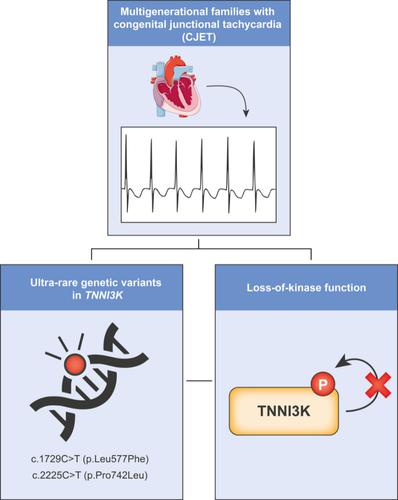当前位置:
X-MOL 学术
›
Clin. Genet.
›
论文详情
Our official English website, www.x-mol.net, welcomes your feedback! (Note: you will need to create a separate account there.)
Reduced kinase function in two ultra‐rare TNNI3K variants in families with congenital junctional ectopic tachycardia
Clinical Genetics ( IF 3.5 ) Pub Date : 2024-03-01 , DOI: 10.1111/cge.14504 Caroline Pham 1, 2 , Tamara T. Koopmann 3, 4 , Jeffrey M. Vinocur 5 , Nico A. Blom 6 , Vivian Nogueira Silbiger 4, 7 , Kirti Mittal 8 , Marianne Bootsma 9 , Kaylin C. A. Palm 1, 2 , Sally‐Ann B. Clur 10, 11 , Daniela Q. C. M. Barge‐Schaapveld 3 , Robert M. Hamilton 12 , Elisabeth M. Lodder 1, 2, 13
Clinical Genetics ( IF 3.5 ) Pub Date : 2024-03-01 , DOI: 10.1111/cge.14504 Caroline Pham 1, 2 , Tamara T. Koopmann 3, 4 , Jeffrey M. Vinocur 5 , Nico A. Blom 6 , Vivian Nogueira Silbiger 4, 7 , Kirti Mittal 8 , Marianne Bootsma 9 , Kaylin C. A. Palm 1, 2 , Sally‐Ann B. Clur 10, 11 , Daniela Q. C. M. Barge‐Schaapveld 3 , Robert M. Hamilton 12 , Elisabeth M. Lodder 1, 2, 13
Affiliation

|
Genetic missense variants in TNNI3K, encoding troponin‐I interacting kinase, have been associated with dilated cardiomyopathy (DCM) and observed in families with supraventricular tachycardias (SVT). Previously, a family harboring the TNNI3K ‐c.1615A > G (p.Thr539Ala) variant presented with congenital junctional ectopic tachycardia (CJET), an arrhythmia that arises from the atrioventricular (AV) node and His bundle. However, this was a relatively small four‐generational family with limited genetic testing (N = 3). We here describe a multigenerational family with CJET harboring a novel ultra‐rare TNNI3K variant: TNNI3K ‐c.1729C > T (p.Leu577Phe). Of all 18 variant carriers, 13 individuals presented with CJET, resulting in a genetic penetrance of 72%. In addition, CJET is reported in another small family harboring TNNI3K ‐c.2225C > T (p.Pro742Leu). Similar to the previously published CJET family, both TNNI3K variants demonstrate a substantial reduction of kinase activity. Our study contributes novel evidence supporting the involvement of TNNI3K genetic variants as significant contributors to CJET, shedding light on potential mechanisms underlying this cardiac arrhythmia.
中文翻译:

先天性交界性异位心动过速家族中两种极其罕见的 TNNI3K 变异体激酶功能降低
遗传错义变异TNNI3K, 编码肌钙蛋白-I 相互作用激酶,与扩张型心肌病 (DCM) 相关,并在室上性心动过速 (SVT) 家族中观察到。此前,一个家庭怀有TNNI3K ‐c.1615A > G (p.Thr539Ala) 变异表现为先天性交界性异位心动过速 (CJET),这是一种由房室 (AV) 结和希氏束引起的心律失常。然而,这是一个相对较小的四代家庭,基因检测有限(氮 = 3)。我们在这里描述了一个多代家庭,其中 CJET 拥有一种新颖的超罕见的TNNI3K 变体:TNNI3K ‐c.1729C > T (p.Leu577Phe)。在所有 18 名变异携带者中,有 13 人患有 CJET,遗传外显率为 72%。此外,据报道CJET在另一个小家庭中窝藏TNNI3K ‐c.2225C > T (p.Pro742Leu)。与之前发布的 CJET 系列类似,两者TNNI3K 变体表现出激酶活性的显着降低。我们的研究提供了支持参与的新证据TNNI3K 遗传变异是 CJET 的重要贡献者,揭示了这种心律失常的潜在机制。
更新日期:2024-03-01
中文翻译:

先天性交界性异位心动过速家族中两种极其罕见的 TNNI3K 变异体激酶功能降低
遗传错义变异



























 京公网安备 11010802027423号
京公网安备 11010802027423号